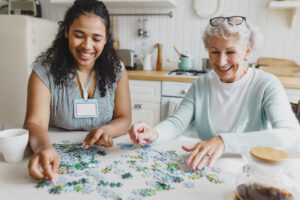Taking inspiration from other cultures can help us provide better care for our own elderly population.
Image source: russavia via wikimediacommons.org
When a quarter of a country’s population is over 65, it gives us reason to pause and wonder whether they’ve learned anything special about the aging process. Japan has been making the news for a while with headlines about its rapidly aging population. In navigating this significant shift, the people of Japan have found ways to raise the bar when it comes to caring for their aging population — “they live longer, they work longer, stay healthier, care for their elderly better.”
Japan has long been regarded as one of the healthiest countries in the world, and boasts one of the highest longevity rates. They eat a healthy diet, which typically consists of “three servings of fish a week, (…) plenty of whole grains, vegetables and soy products too, more tofu and more konbu seaweed than anyone else in the world, as well as squid and octopus.” But just as important as food is their attitude toward death, and their devotion to cultivating ikigai, one’s daily sense of purpose or “reason for being.”
Image source: Not1kk7010 via wikimediacommons.org
Pursuing passions for a lifetime
The quality of life is high for Japan’s aging population. In addition to eating nutritious cuisine, a common aspect found amongst seniors here is their desire to continue working up until their final days. And it doesn’t need to be paid work, or traditional vocations — it can mean an ongoing devotion toward a particular sport, or gardening. Other common activities for Japan’s elders include volunteering, taking up an art like calligraphy, or learning a new subject. Though they might officially retire from their job, many Japanese people will use the break as an opportunity to pursue other hobbies they’ve been interested in. Japanese elders don’t lose their passion for life as they grow old.
In many ways, the elders of Japan live more vivaciously than many younger people here in the West. Humor is a staple during conversation, and sports are played with a competitive spirit, no matter how old the players are. Since death is not seen as something to fear, Japanese are “less concerned with extending life than in maintaining its quality.” As one elderly Japanese man enthuses, “Our motto is: ‘Let’s do kendo until we’re 100.'”
Image source: katorisi via wikimediacommons.org
Supportive technology and community care
What, then, are some of the tangible ways in which Japan is thoughtfully serving its aging population? The country has been at the fore of technology for seniors: they’ve introduced senior-friendly products including a smartphone made specifically for elderly people, and smart canes. The smartphone, which is increasingly becoming available in more international markets, has an interface with increased font and icon sizes, while keeping the visual clutter to a minimum — only basic apps are displayed for simplicity’s sake. The smart canes, still in the prototype phase, come with a navigation system that allows other people (like family and friends) to track the user’s whereabouts. These are thoughtful products created with the needs of elderly people in mind.
Japan also has shopping centers that cater specifically to their aging population. This means that remaining independent is easier: it’s possible for seniors to get everything from eye-glasses to groceries in one place. Even the numbers on price tags are displayed in large size to make reading easier, and the mall staff are accustomed to serving elderly people with care and respect.
Connecting by giving back
Perhaps most touching is Japan’s commitment to creating a system that ensures compassion support for seniors. Hureai Kippu, which translates to ‘ticket for a caring relationship’ is a “kind of credit system that recognises the efforts people to support each other with a ‘ticket’ which is worth the price of a home-cooked meal, and which can be banked until later.” In Japan, they have used this system since 1995 as a way to offer the elderly sufficient support:
“[the system] provides care for older people through the exchange of time credits. People donate their time by helping a senior and are issued tickets as payment which can then be used by a senior to “buy” services.”
This is especially helpful with the current trend of children moving away from their hometowns, unable to personally care for their aging parents. It’s also something that North America could benefit from implementing more. Paying it forward feels good: this pragmatic structure successfully encourages people to be part of the solution.
Contributing to the care of our aging population can be fulfilling in ways most of us might never imagine. Even if your city doesn’t have this type of system, we can all use it as inspiration to offer more of our time and energy to those in need. Being an active part of our aging community is a rewarding experience — a worthwhile opportunity that undoubtedly shapes our personal character, and fuels our spirit.
If you are unsure of how to best help an aging loved one, the trained and compassionate staff at the Institute on Aging is here to help you make that decision and gain the best in at-home senior care. Contact us to find out more.








